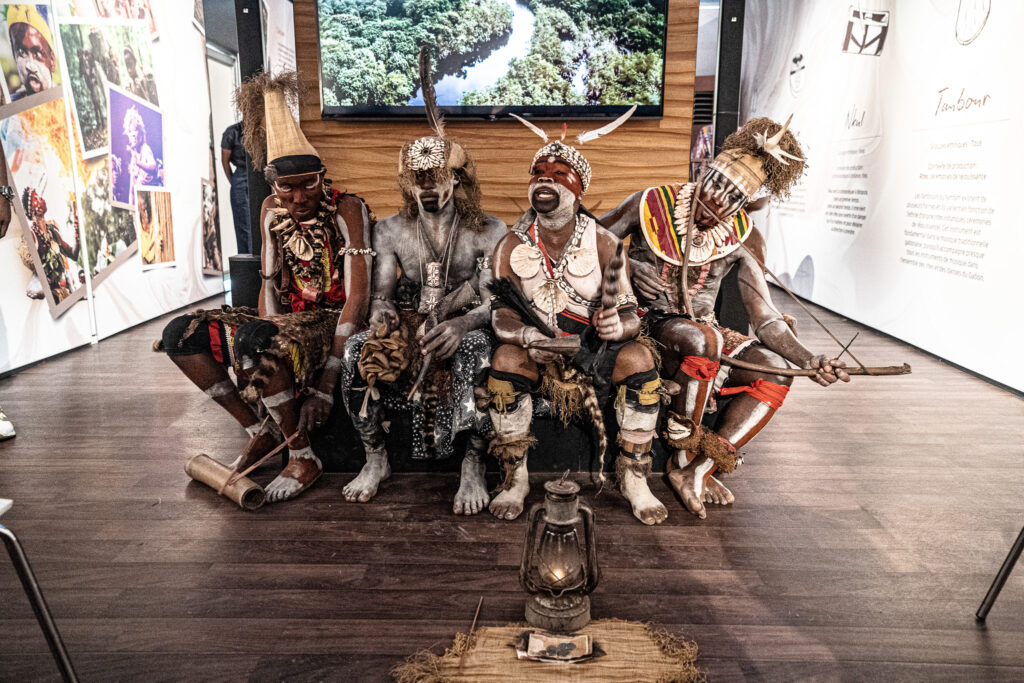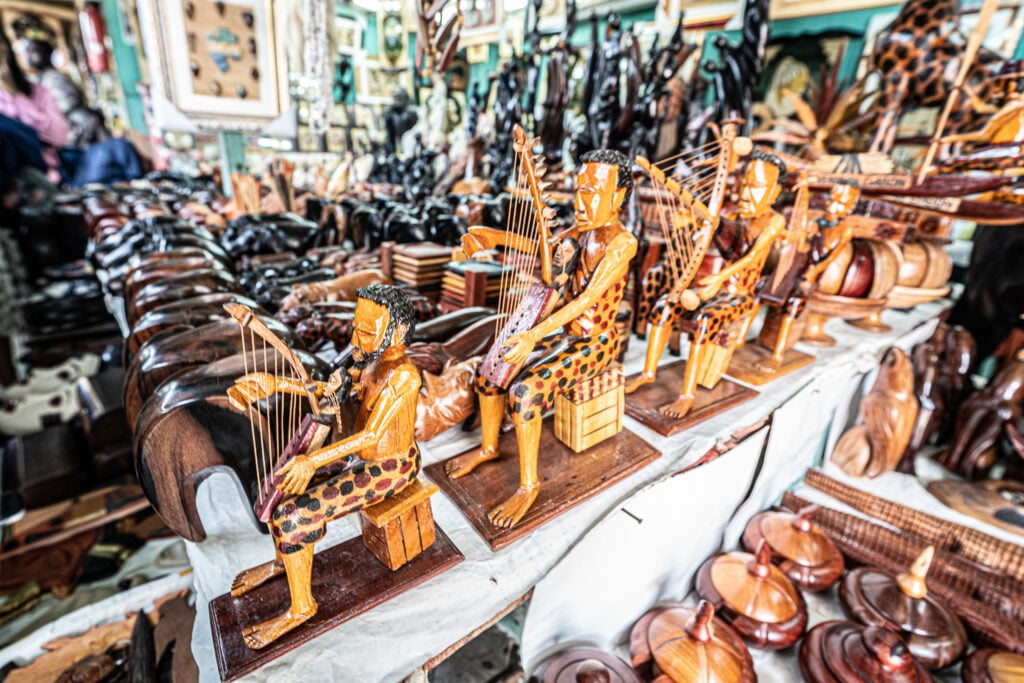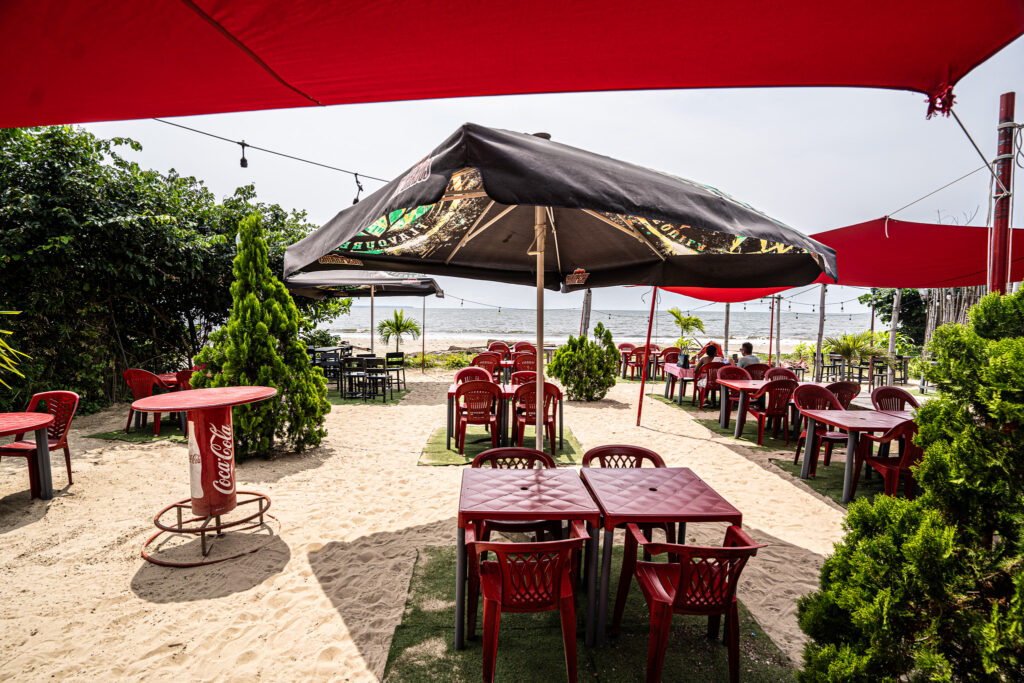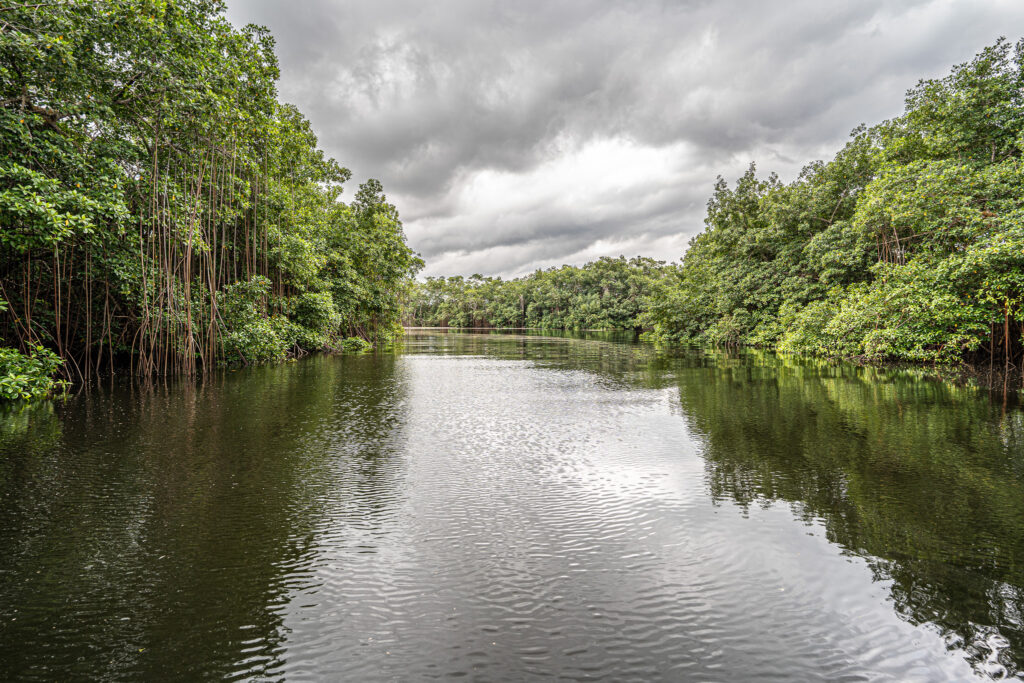From beachfront beers overlooking the Atlantic Ocean to safari tours of Pongara National Park, here are the best things to do in Libreville, Gabon.
“Gabon is like a big village,” said Ghislaine Bouassa, a Gabonese tour guide. “And Libreville is just the biggest village of them all.” He wasn’t wrong. Libreville, the Gabonese capital, is like a patchwork of villages and peoples, all drawing on the diverse multitudes of Gabon’s many cultures, languages and influences to present a microcosm of the Central African nation to visitors.
With few high rise buildings, and ready access to protected areas of mangroves, rainforest and beaches, Libreville is hardly a city in the traditional sense. I’ll be honest, there are few traditional sightseeing attractions that you’d expect from a capital – aside from the odd museum and an open-air church – but the real attraction is found in the local markets, or the jungle strewn landscapes that surround Libreville.
There’s history here, though, and the city’s origins can be traced back to 1849, when a group of freed slaves settled in the area. These emancipated individuals named their new home ‘Libreville’, meaning ‘Freetown’, to symbolise their newfound freedom. Over time, Libreville grew under French colonial rule, becoming an administrative and trade hub due to its strategic location along the Atlantic coast until independence in 1960 brought with it a burgeoning boom in nation building efforts that can be seen in the Presidential Palace and national institutions.
Now Libreville sits at the heart of Gabonese efforts to develop an ecotourism industry, and it’s the perfect base from which to explore the country’s nature and wildlife. If you’re planning a West African adventure, then keep reading, as I count down the best things to do in Libreville.
Table of Contents
Things to do in Libreville
Gabon has traditionally been one of the more stable Central African nations, with one of the highest GDPs in Africa and a wealth of natural resources that’s allowed for an extensive public wealth fund that’s fuelled development. I visited in 2023, and at the time, Gabon was shifting its focus from resource exploitation (mining, logging and oil extraction) to a vision of a nature-based economy where ecotourism could help to protect its biodiverse environment.
However, the long standing President, Mr. Ali Bongo (who once released a Funk album) was later ousted in a coup in 2023, hinting at the underlying stresses caused by endemic corruption and economic disparity. The ecotourism vision remains in its infantile stages, and while the country has stabilised again, there’s no doubt that a trip here is one for adventure travellers used to the unpredictability of African travel. That being said, stay abreast of political events, take a French phrasebook along, and you’ll find that with Libreville, the capital, as your base, the nation has a lot to offer.
1. Delve into history at the National Museum of Arts, Rites, and Traditions of Gabon
The best place to start exploring Libreville is The National Museum of Arts, Rites, and Traditions of Gabon, where a veritable treasure trove of Gabonese culture and heritage awaits you in the capital’s premier museum.
The museum was established to preserve and showcase the diversity of Gabon’s many ethnic groups, including the Fang, Eshira, Punu and Teke that all call the country home. You’ll find an extensive collection of cultural and artistic exhibits, ranging from carved masks and traditional musical instruments to ceremonial objects and weapons of war.
Best of all, the National Museum of Arts, Rites and Traditions of Gabon now hosts a new exhibition detailing the finds in the Iroungou Cave. This remarkable archaeological and palaeontological site in Central Gabon has garnered significant attention for its ancient human and animal remains.
Discovered relatively recently, the cave has provided valuable insights into the prehistoric era of Central Africa. Among the notable finds are human bones that suggest the presence of a burial site, dating back thousands of years. These remains indicate complex burial practices and hint at the social and cultural structures of early human communities in the region. Learn more at the museum in Libreville.

2. Shop for crafts and souvenirs at the Village des Artisans
“You can discover a little bit of Gabonese folklore in the market,” said Nathanielle Oyabi, a local tour guide, as she led me into the Village des Artisans. “You can meet local artisans, drink fruit flavoured rums and buy souvenirs!”
Oyabi explained how the Village des Artisans, in central Libreville, was established by the government as a way to provide economic opportunities for local artisans. “It’s very difficult for young people to find jobs in Libreville,” she said as we walked through stalls selling carved elephants and traditional Gabonese masks. “So many invest in their crafts to create their own work in the markets. The government has established training programmes through the sovereign wealth fund to assist people with preserving these crafts and starting small businesses.”
The Village des Artisans is a noble project indeed, although admittedly, the offerings are inevitably touristy in nature. Oyabi said she never shops here, largely because she doesn’t need anymore carved hippos in her living room. For tourists though, the market offers an insight into local arts, and plenty of opportunities to trade your Central African Francs for souvenirs.

3. Shop locally at Marche du Mont-Bouet
For a more local shopping experience, then make your way to Marché du Mont-Bouët, the largest market in Libreville. A bustling epicentre of commerce and daily life in Gabon’s capital, you’ll get a real insight into the local culture, cuisine and economy.
Local vendors fill the market with a kaleidoscope of goods, from fresh produce, seafood, and meats to textiles, electronics, and traditional crafts. You won’t find many souvenirs here, but you can pick up the freshest mangoes you’ve ever tried!

4. Don’t linger outside the Presidential Palace!
If, like me, you’re intrigued by Central African politics, then it’s well worth taking a walk past the monstrous Presidential Palace on Libreville’s seafront. I say to ‘walk past’, because it’s not open to the public. If you start to linger outside, you’ll inevitably be moved on by the security guards. Don’t even think about taking pictures unless you don’t mind seeing the inside of a Gabonese police station!
However, the Presidential Palace in Libreville is a striking symbol of Gabon’s political landscape. Overlooking the Atlantic Ocean, this grand structure serves as the official residence of the President of Gabon, and it was built by the Bongo family dynasty that ruled the country (and enriched themselves in the process) until the recent coup in 2023.
It’s really a place of contradictions, demonstrating the follies of dictatorship, the vast reserves of wealth found in Gabon and the horrific inequality that characterises the capital (Gabon has one of the highest GDPs in Africa, and yet, the African Development Bank Group estimates that as much as 33% of the nation’s population live below the poverty line).
Read more: 10 Best Places to Visit in Gabon
5. Enjoy waterfront entertainment at La Baie des Rois
La Baie des Rois (The Bay of Kings) is an ambitious waterfront development combining modern urban planning and leisure in Gabon’s capital. Stretching along the coastline, this area is designed to be a hub of commercial, residential, and recreational activities overlooking the Atlantic Ocean. The project aims to transform the city’s skyline and enhance its tourism appeal.
La Baie des Rois is home to a variety of cultural attractions and entertainment venues, including restaurants, ice cream parlours and a beautifully landscaped waterfront boulevard. The empty space is turned over to temporary events, which when I visited, included the cultural exhibitions which had recently been on display at the Dubai Expo.

6. Get spiritual at St. Michael’s Church (L’Eglise St-Michel)
St. Michael’s Church, or L’Eglise St-Michel, is Libreville’s most iconic religious landmark. Located in the heart of Gabon’s capital, this church is particularly famous for its stunning wooden columns, each intricately carved by a blind local artist, depicting scenes from the Bible and Gabonese folklore. The craftsmanship of these columns reflects a unique fusion of Christian and indigenous artistic traditions, creating a truly impressive sight.
Built in the early 20th century, L’Eglise St-Michel serves as a central place of worship and community gathering. Its spiritual atmosphere and distinctive open-air design draw both worshippers and tourists, offering a peaceful retreat from the chaos of the city.
Read more: How Many Countries Are in Central Africa? Everything You Need to Know.
7. Sink a few Regab beers at La Voile Rouge
La Voile Rouge is one of Libreville’s best beachfront bars. Situated along the sandy Atlantic coastline, you can sit back in a hammock or at the rustic wooden bar and take in breezy views of the ocean. The bar leads right onto the beach, making this an excellent place to sink a few of the local Regab beers at sunset.
I enjoyed some excellent seafood here too, with a menu that features plenty of fresh fish, crab, lobster and prawns, all barbecued or grilled and served with mounds of sides. You can also try a few of the local Gabonese staples, including Nyembwe Chicken, a spicy favourite prepared with palm oil that’s seen as the national dish of Gabon.

8. Experience Gabon’s nature at Pongara National Park
“If we see an elephant, don’t run. Don’t separate. Stay together,” said Ghislaine Bouassa, a Gabonese guide who specialises in jungle walks and safaris. “Seriously, we have to be safe. But this is the real Gabon, so welcome!”
I was somewhere in the dense rainforest within Pongara National Park, putting my faith in Ghislaine to show me the way. A vast protected area featuring some 929 square kilometres of mangroves, forest, savannah and beaches, I was surprised to discover that some of Gabon’s best wildlife can be seen just across the Gabon Estuary to the south of Libreville.
The park is easily accessible by boat, and there are a range of hotels and safari lodges lining the coastline. I’d recommend staying at Pongara Lodge, which is run by Luxury Green Resorts. They’ll organise your boat transfers from Libreville (it only takes about twenty minutes to cross the estuary), they can arrange jungle walks, canoeing trips, boat rides and ATV safaris through Pongara National Park, and they do a mean seafood barbecue on the beach.
Pongara National Park offers a serious taste of Gabon’s biodiversity, and you’ll likely see elephants, forest buffalo and perhaps even the fabled ‘Surfing Hippos‘ which love the Atlantic waves. The beaches, especially around Pointe Denis, are a haven for endangered sea turtles, and if you’re visiting between November and February you’ll be able to see them nesting and hatching along the protected shores of the Gabon Estuary.

9. Take a boat tour of the Gabon Estuary
The Gabon Estuary is where the Komo River meets the Atlantic Ocean. It’s an expansive waterway, lined by the urban sprawl of Libreville on the northern side and the protected rainforests and mangroves of Pongara National Park on the other.
Head down to Michel Marine, the main harbour for boats heading over to Pongara, and you can join sightseeing tours of the estuary. You’ll see the stark juxtaposition of man and nature as you head onto the water, as oil tankers and container ships make their way out into the ocean.
As soon as you reach the dense mangroves on the opposite banks, though, you’ll be a world away from the city. You might even spot a few dolphins, crocs or hippos on the way. You can contact Gabon Adventures to organise bespoke sightseeing tours of the Gabon Estuary and Pongara National Park.

10. Enjoy the white sands of Pointe Denis
Pointe Denis is located just a short boat ride from Libreville, across the Gabon Estuary on the shores of Pongara National Park. This pristine beach, with its soft white sands, is a popular weekend escape from the city.
Along the coast, you’ll find several hotels and guesthouses, which are all comparatively cheaper to book than the safari lodge within the park itself. President Bongo built a house here too, before he was ousted, which means it must be good! There are regular ‘ferries’ (more like large Pirogues) which depart from Michel Marine in Libreville.
As I already mentioned earlier on, a unique highlight of Pointe Denis is its role as a nesting site for endangered sea turtles. From November to February, you can witness these magnificent creatures laying their eggs, a truly remarkable sight that underscores the area’s ecological significance.

11. Go whale watching
The coastal waters off Gabon are known for being one of the best places in West Africa to observe humpback whales. These enormous marine creatures migrate to Gabon’s warm waters between July and September for breeding and calving.
Boat tours from Libreville provide opportunities to see these magnificent animals along the coast. The tours often offer the chance to observe whales breaching and tail-slapping, along with other marine wildlife such as dolphins and various seabirds.
You can organise trips in whale watching season through companies like Gabon Adventures (I know, there’s not much competition in Gabon when it comes to tourism!)
Read more: How Many Countries Are in Africa? Everything You Need to Know.
12. Connect with nature at Akanda National Park
Akanda National Park, located to the north of Libreville, is a pristine natural sanctuary renowned for its rich biodiversity and striking landscapes. Spanning over 540 square kilometres, the park is characterised by its extensive mangrove forests, tidal beaches, and coastal lagoons. This diverse habitat makes Akanda an excellent site for birdwatchers, offering the chance to observe a variety of bird species, including the African grey parrot and various migratory birds.
The park’s lush mangroves and waterways are not only vital for wildlife but also support the local fishing communities. Visit Akanda National Park, and you can explore its environment by joining guided boat tours along the extensive waterways. Like Pongara National Park, Akanda National Park is literally on Libreville’s doorstep, making this a must-see for adventure enthusiasts.

13. Meet the mad French Shaman of Libreville
The whackiest part of my stay in Libreville occurred when my tour guide took our group to meet a mad French Shaman. Tatayo, as he styles himself, offers tourists the chance to indulge their hedonistic or spiritual desires with a stay at his lodge in Libreville. There, they embark on a series of ‘initiations’ drawn from the Missoko Bwiti traditions of Gabonese tribes.
The initiations involve imbibing a plant named ‘Iboga‘, which induces hallucinations. I’m not recommending this experience because Iboga can be fatal. If you’re looking for something a little different to do, then you can visit Tatayo’s lodge and learn more about the traditions and ceremonies, while meeting with the many spiritual types who stay here for weeks at a time as part of their initiations.
Tatayo doesn’t advertise his ‘services’, so ask around when you’re in Libreville if this is something you’re interested in.

Read more: How Many Countries Are in West Africa? Everything You Need to Know.
Map of the best things to do in Libreville
Here’s a map of the best things to do in Libreville:
There you have it! The best things to do in Libreville. Are you planning a trip to Gabon? Let me know in the comments below.



Recent Comments